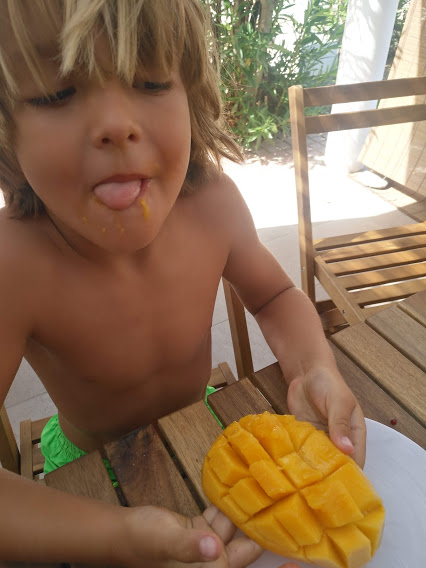First Mango Spotted In Gran Canaria
The Gran Canaria mango season runs from summer through to February depending on the year. The first ones normally appear in the shops in July but this year they are really early.
This year Spar supermarkets are already selling little ones at an outrageous 10 euros per kilo. However, prices should fall fast as the main crop starts to ripen in the warmest spots in south Gran Canaria.
How to choose a good mango in Gran Canaria
Mangos grow all over Gran Canaria but the best ones come from the south and south west valleys like Arguineguín, Mogán and  Veneguera. Really fresh ones have a faint white bloom on the skin, like a fine layer of chalk dust.
Veneguera. Really fresh ones have a faint white bloom on the skin, like a fine layer of chalk dust.
If you find a mango that smells great, it will taste just as good no matter what it looks like.The tiny yellow ones, often with sticky skin, are fibrous inside but taste delicious. Larger yellow or green ones have no fibres and you can smell them as soon as you walk into the shop.
Some varieties, like the big red ones, are delicious but don't have any odour at all. Choose one that is slightly soft to the touch but doesn't have black spots or by the stem (which indicate that it has started to rot before it ripens).
It's often best to buy local fruit in Gran Canaria from small shops and fruterias rather than the big supermarkets. The supply chain is shorter and the fruit less likely to be picked early and kept in cold storage.
Gran Canaria Info recommends:
- Default
- Title
- Date
- Random
Join the Gran Canaria Info newsletter list
Gran Canaria info recommends
-

Casa Romantica: A Classic Gran Canaria Restaurant Reborn
-

The Best Value Car Rental Service In Gran Canaria
-

Which Gran Canaria Airport Transfer Service Is The Best?
-

Off The Beaten Track With A Gran Canaria Buggy Trip
-

Gran Canaria Shopping: Start At Fundgrube For Price & Quality
-

Hassle-Free Gran Canaria Car Hire
- 1
Follow us on Facebook
Tip of the day
-
Tip Of The Day: Avoid Bank Card Charges By Paying In Euros

Save money and avoid rip-off bank charges while in Gran Canaria by paying in euros when using your credit or debit card.
Many bars and restaurants in Gran Canaria, and in almost all European holiday destinations, give you the option of paying in euros or in your home currency. Opting for your own currency, while it may seem like the safer option, can add as much as 5% to the bill as it triggers dynamic currency conversion.
DCC basically means that the exchange rate is calculated at point of sale rather than by your bank. It allows you to see the total cost of the transaction in your own currency but adds up to 5% to the total because it uses a terrible exchange rate.
Since the extra money is shared between your bank and the merchant, some places will automatically bill you in your own currency and hope you don't notice. You have the legal right to refuse and void the transaction should this happen.
ATMs too
The same applies when taking money out of ATM machines in Gran Canaria (and anywhere in Europe); Always choose the local currency option to avoid losing money to poor exchange rates.
If you opt for the local currency option, using bank ATMs is often the cheapest and safest way of getting euros in Gran Canaria. It's far safer than having a big pile of euros hidden in your room or tucked into your shorts.
More details in this Daily Telegraph article.
Latest articles
Who's Online
We have 3360 guests and no members online






